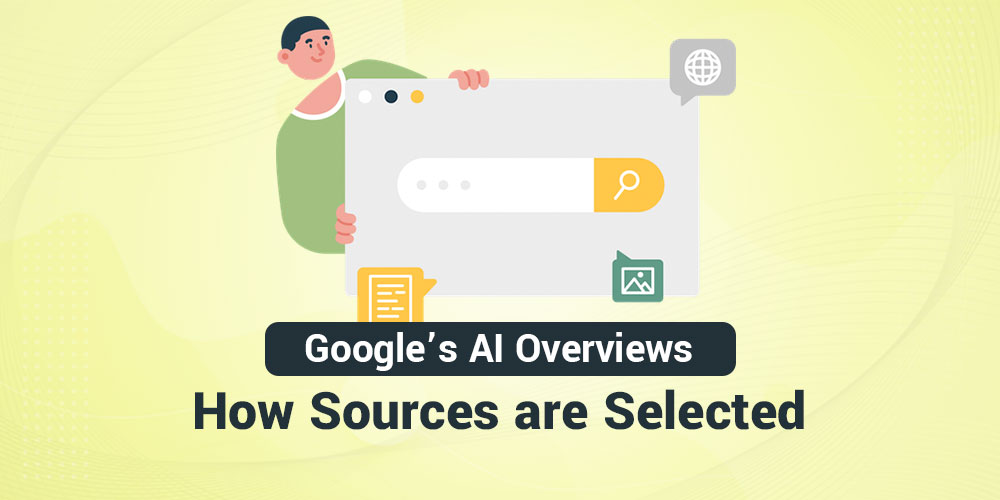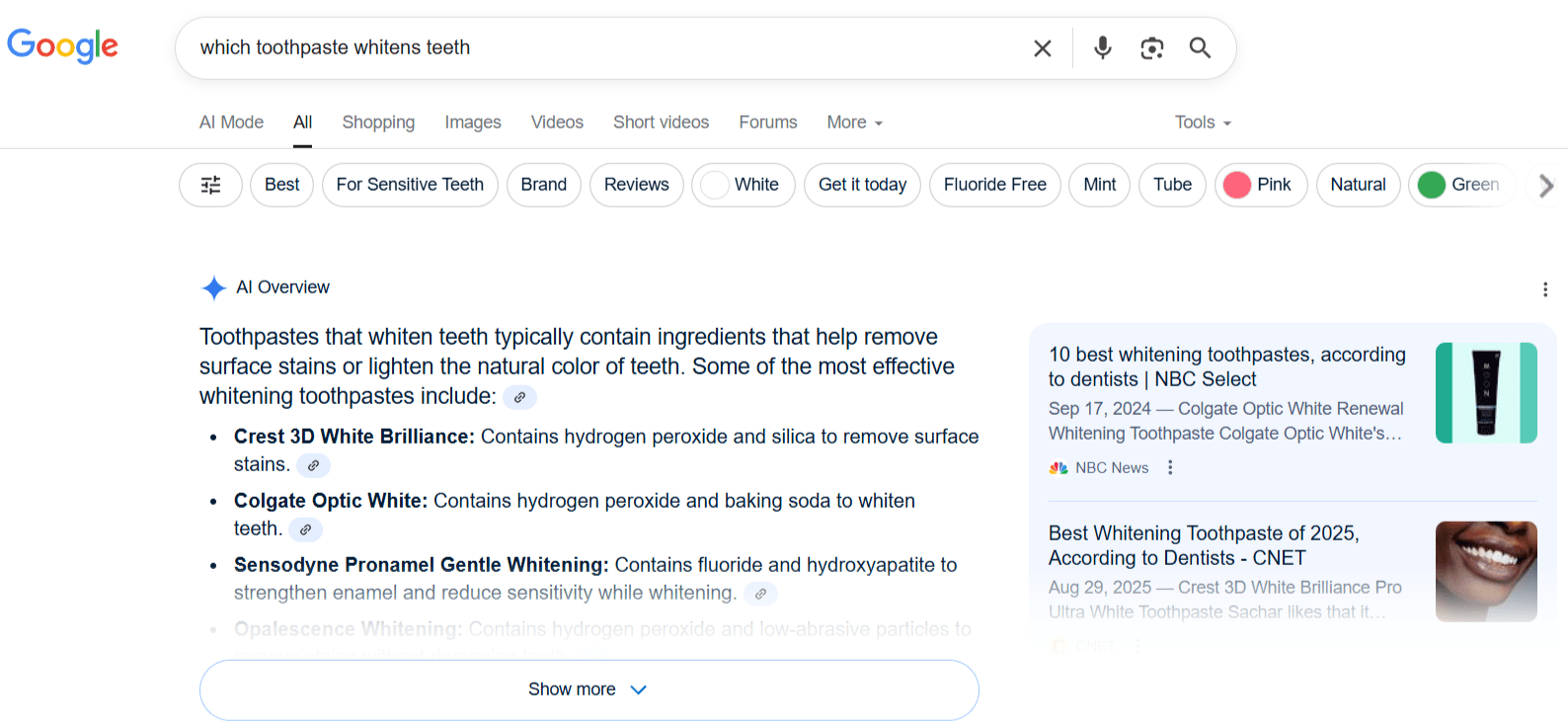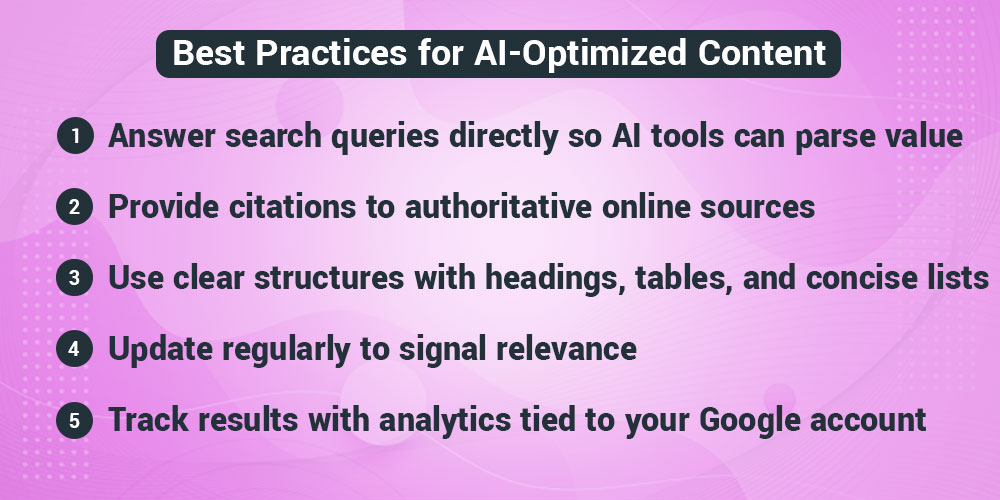
Key Takeaways
Be sure to take note of:
- Overviews now appear in over 50 % of searches: AI Overviews dominate search visibility as of August 2025. (From 18 % in March 2025)
- Gemini and “fan-out” shape selections: Google’s AI uses query breakdowns and LLM like Gemini to surface sources.
- Authority, freshness, structure matter: High-ranking pages that are updated, structured, and richly sourced perform better.
- Schema, engagement and clarity boost inclusion: Markup and user metrics can tip source selection in your favor.
Let’s talk about how we can improve your Google AI Overview results.
Google has introduced a new way of shaping what users see at the very top of search. With AI Overviews, artificial intelligence generates summaries that highlight selected sources and provide context-rich answers.
These summaries fundamentally change how people find information and which businesses gain visibility.
For marketers and business owners, understanding how Google’s AI Overviews select sources has become essential for maintaining traffic and conversions.
Understanding AI Overviews in Google Search
What Are AI Overviews?
AI Overviews are AI-generated snippets that bring together insights from multiple online sources. They appear at the very top of the search results page (SERP), often above organic listings. Unlike traditional snippets that quote single excerpts, AI Overviews synthesize information from multiple sources.
Why Did Google Introduce Them?
This feature evolved from Google’s Search Generative Experience (SGE), which was launched in May 2023 and rebranded as AI Overviews when it launched publicly in the U.S. in May 2024. This feature addresses competitive pressure from ChatGPT, Perplexity, and other AI applications.
AI Overviews deliver more complete answers to complex queries improving the overall user experience. Rather than forcing users to click through multiple links, the Overview consolidates the most relevant insights into one view.

Key Characteristics of AI Overviews
- Placement: Displayed at the top of the results page
- Format: Synthesized responses built from a range of sources
- Purpose: Deliver faster, more complete answers
- Impact: Shift traffic flows away from single sites
The Challenge for Businesses
AI Overviews simplify the search experience for users, yet they raise challenges for businesses. While earning a citation can increase visibility, excluded content loses clicks even with top 10 rankings.
AI features in search are here to stay. Recent data shows AI Overviews now appear in over 50% of all searches as of August 2025, representing a dramatic increase from 18% in March 2025, steadily changing SEO. Companies that don’t adapt risk losing visibility as Overviews become dominant.
Forward thinking organizations are refining their strategies to improve AI visibility. Adapting your strategy is essential since Google remains committed to this feature.
“People use Search more with AI Overviews and usage grows over time as people learn that they can ask new types of questions.” – Sundar Pichai, Google CEO
How Users Experience AI Overviews
For Google users, the process feels simple:
- A search query is entered in Google Search.
- The AI model combines its pre-trained knowledge base with information scanned from multiple online sources and websites.
- A synthesized response or AI-generated answers appear in a highlighted box.
- Citations to original sources in Google are listed below the overview.
When AI Overviews were first launched, users saw them most often during complex or exploratory searches. But today, we’re all experiencing Overviews instead of traditional snippets, even on ecommerce searches.
Key differences between AI Overviews and Traditional SERP Snippets include:
| Feature | AI Overviews | Traditional Snippets |
| Source | Range of sources combined | Single page excerpt |
| Placement | Top of results page | Below ads or above organic listings |
| Content | AI-generated results with context | Exact text from one page |
| Goal | Help users find quick, contextual answers | Highlight the most relevant single answer |
| Interaction | Expands, includes links and follow-ups | Static preview of a single page |
| Attribution | Multiple sources cited inline | Single source shown below snippet |
How AI Overviews Work
The Multi-Layered Selection Process
Google’s AI Overviews are powered by the Gemini large language model, which scans multiple sources using advanced natural language processing to determine the best information for each query.
The system combines pre-trained knowledge with real-time information to generate contextually informed, factually current responses.
This goes well beyond keyword matching, weighing authority, freshness, topical alignment, and usability. The system employs Google’s ‘query fan-out’ technique, breaking down complex queries into multiple subtopics and issuing concurrent searches across different data sources before synthesizing a comprehensive response.
AI Overviews have graduated from their experimental Search Labs phase and are now a core Google Search feature, though Google continues testing additional AI capabilities through Search Labs experiments like AI Mode.
Traditional Search Results Rankings Play a Role
The model evaluates sources in Google across publications, blogs, forums, and repositories. Research from Ahrefs shows that 76% of AI Overview citations come from pages ranking in the top 10 organic results, with 48-52% of citations overlapping traditional top-ranking pages.
Evaluating Context and Intent
Google pays close attention to context by studying how phrases and sentences connect rather than relying solely on keywords. This allows it to interpret not just what a page says, but exactly how AI should respond to intent.
A query about “AI citations” might produce an overview that includes definitions, real-world examples, and markup guidance, making the overview helpful rather than superficial.
Importance of Usability
Usability influences whether a page is selected. Pages that use lists, tables, or FAQs often perform better since they align with how summaries are structured.
Criteria Behind AI Overview Sources
1. Relevance to Search Queries
Relevance anchors every AI Overview. Google’s systems interpret both the words in a query and the intent behind them. Pages that answer questions directly, supported by context, are far more likely to be cited.
Reminder
Effective pages anticipate related questions and connect them to broader search journeys. A piece on “SEO strategy,” for example, should also touch on “search visibility” and “keyword intent.”
Pages that define terms, explain context, and link related ideas perform better. Fresh, regularly updated content also signals current expertise, improving inclusion chances.
2. Authority and Backlinks
Authority has always driven inclusion across Google’s ecosystem, and AI Overviews are no exception. Selected pages typically come from authoritative domains with strong backlink profiles that serve as trust signals.
Ranking in the top 10 frequently overlaps with inclusion, as well. However, not all backlinks carry equal weight. Links from niche-relevant sites or respected publications matter more than links from generic directories. In fact, low quality links or a lack of diversity can even hurt your visibility.
A diverse backlink profile includes editorial mentions, guest features, social media mentions, PR, and natural references across the web. Together, this diversity strengthens authority. Keep in mind that Google doesn’t always prioritize the volume of backlinks; relevance and credibility win the day.
3. Content Quality and Depth
Quality sets strong content apart from overlooked pages. Google favors pages that go beyond surface-level commentary. Articles that explore a topic from multiple angles, present evidence, and provide clear explanations are more likely to be cited.
Reminder
Google’s AI elevates content that answers both explicit and implied questions.
Depth doesn’t require unnecessary length. Instead, it means structuring content so readers and AI systems can extract value quickly while still accessing detail when needed. Real-world examples, like case studies and references build credibility so use them whenever possible.
4. Schema and Markup Signals
Technical signals help Google interpret pages. Schema markup converts text into structured data the system can parse. Adding FAQ schema, product markup, or review markup clarifies content, increasing the chance of inclusion in AI Overview results.
There are a number of different types of Schema markup so make sure you understand what they are and how to use them.
Markup often tips the scales between two strong content candidates. A product page with structured review data is more likely to be cited than one without.
In eCommerce, markup strongly affects whether products appear in features like AI Overviews for eCommerce snapshots. [HYPERLINK: AI Overviews for eCommerce: Getting Products Featured in Snapshots | Anchor suggestions: eCommerce AI Overviews, product visibility in AI, AI product snapshots]
5. User Engagement Metrics

User engagement sends another layer of signals you don’t want to ignore. Metrics like website dwell time, scroll depth, and return visits show content is meeting expectations. High bounce rates signal the opposite. Pages that keep visitors engaged stand a better chance of appearing in AI Overviews. If you’re looking for ways to improve user behavior on your site, check out our MaximizeOS service.
Behavioral data has shaped search results for years and remains relevant for AI-powered search. Some easy ways to improve Content include:
- integrates multimedia like video,
- clear navigation, and
- interactive prompts on critical pages.
For B2B websites, detailed service pages and case studies sustain engagement, aligning with how AI Overviews for B2B highlight service-based companies.
How to Get Cited in AI Overviews
Earning a place in Google’s AI Overviews select sources takes more than strong rankings. It requires understanding how generative AI evaluates credibility. Analysis of thousands of queries reveals common patterns.
Start with alignment to intent. AI chooses sources that don’t just include keywords but offer context-rich answers. Anticipating follow-up questions, addressing nuance, and offering clear explanations strengthen visibility. Instead of a short blog on “SEO,” create a comprehensive guide covering schema, backlinks, analytics, and query variations.
Markup and technical clarity often decide between two strong contenders. FAQ schema, reviews, and structured content improve parsing. Businesses that refine markup usually see better performance.
Formatting also plays a role. Pages organized with headings, lists, and steps are easier to parse. Summaries lean toward content that can be transformed into AI-generated answers.
As a permanent feature with ongoing development, expect continuous changes. Teams that test adjustments in queries and formatting learn how to influence results.
Best Practices for AI-Optimized Content
Follow these practices::
- Answer search queries directly so AI tools can parse value
- Provide citations to authoritative online sources
- Use clear structures with headings, tables, and concise lists
- Update regularly to signal relevance
- Track results with analytics tied to your Google account

Evolution and Future Developments
Google continues refining these features through Search Labs experimentation while expanding their core functionality. As the system evolves, several key patterns have emerged:
Current Development Priorities:
- Multiple sources are always cited for credibility
- Accuracy takes priority over speed
- Organic results form the backbone of citations
Expected Changes:
- More AI-generated results for complex, layered queries
- Greater reliance on markup and structured data
- Stronger emphasis on content optimized for AI parsing
- Evolving definitions of authority in AI-powered search
Google does not guarantee stability as these tools develop. Additional generative AI features will likely become available, giving marketers new opportunities to refine content strategies.
Since AI Overviews cannot be disabled by users or businesses, optimization for this feature is essential for maintaining search visibility. Forward-looking marketers should expect continuous experimentation and adapt their strategies accordingly.
Taking Action Now
Google’s AI Overviews will shape future visibility. By refining your SEO strategy with your AIO strategy, aligning with model priorities, and using schema effectively, you raise your chances of being cited.
Visibility on Google is no longer just about organic search results. It is about making sure your brand remains visible wherever Google presents answers. To thrive in AI-powered search, you must create content that secures a place in Google AI Overviews and keeps your business at the top of the search journey.

